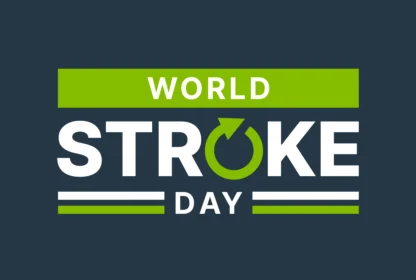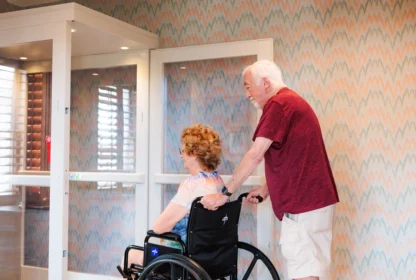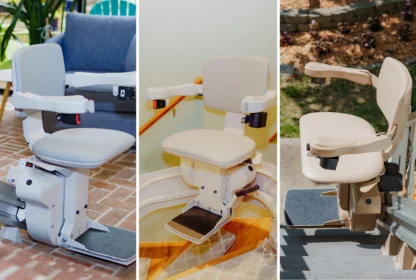
Introduction on Stair Lifts
All over the country and around the world, people are aging, and many of them are aging in place. Aging in place encompasses a broad range of ideas and issues. However, at its most basic level, it is closely connected to an individual’s desire to stay home – the place where most people (more than 90%, according to AARP) would prefer to remain for as long as possible. They would rather not transition to a senior care community unless or until it’s absolutely necessary.
Unfortunately, though, many seniors hover a fine line between independence and the need for assistance. Some are just one medical emergency, fall, fracture, or diagnosis away from requiring advanced care. This is the primary reason that many long-distance caregivers and concerned family members worry about senior relatives or friends who either live alone, who are in poor/failing health, or live with a frail spouse who has care needs of his/her own. Also, many seniors tend to live in older homes that may have steep stairs or other structural features that are difficult for aging bodies to safely navigate.
However, a move to assisted living or a nursing home may not be necessary just because getting up and down the stairs is a challenge or concern. Some care transitions occur because there is an unmet need at home, a need that may be easily addressed. Stairlifts, which are the focus of this guide, are one potential solution for meeting a need at home and preventing a premature senior care transition.
Who Needs Stair Lifts?
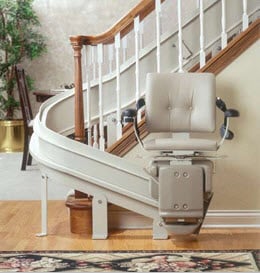 If you’ve seen Disney Pixar’s hit film “Up,” you may recall that Carl Fredericksen, the main character and a widower in his 70s, relied on a stair lift to transport him between the first and second floors of his charming old cottage, a place to which he had deep emotional connections. Even though he was able to walk with the assistance of a four-pronged cane, walking up and down the stairs can be a much more menacing task due to visual impairments, depth perception issues, and general aging-related losses.
If you’ve seen Disney Pixar’s hit film “Up,” you may recall that Carl Fredericksen, the main character and a widower in his 70s, relied on a stair lift to transport him between the first and second floors of his charming old cottage, a place to which he had deep emotional connections. Even though he was able to walk with the assistance of a four-pronged cane, walking up and down the stairs can be a much more menacing task due to visual impairments, depth perception issues, and general aging-related losses.
Perhaps there is a mobility issue that limits an individual’s ability to get up and down the stairs to access a 2nd-floor bathroom or bedroom. In all other respects, the senior is healthy, competent, and able to live alone without daily assistance. In some cases, a frail senior may not be completely immobile, but navigating the stairs is a health risk not worth taking. If a transition to one-floor living is not affordable or practical, a stairlift may be the best bet for aging in place safely and efficiently.
How Do I Pay for a Stair Lift
Even if you decide a stairlift is the best solution, it’s not a free one. Purchasing and installing a stairlift can be an expensive process, but can you really put a price tag on independence? And, when compared to the monthly costs of assisted living or nursing home care, it just doesn’t even come close. Read More: Stair Lift Cost: A Complete Guide for Consumers
For a senior who wants to age in place, a stairlift is a worthwhile investment. There are a few funding options available – check them out below:
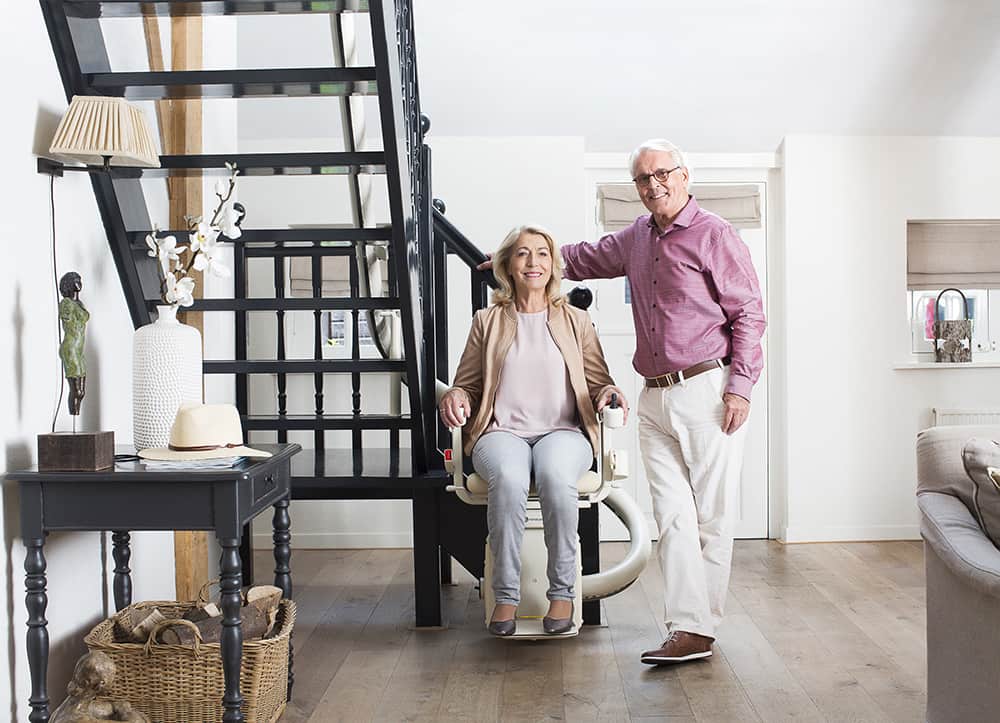
Claim a deduction.
Russell Glickman, a DC-based home design and remodeling expert, recommends conferring with a Certified Public Accountant (CPA) to find out whether you or a loved one is eligible to deduct the cost of a home modification — like a stairlift installation — on your federal income taxes. You need a written recommendation from your doctor as proof that the modifications are medically necessary. Glickman also states that you can claim a deduction for the costs of operating and maintaining the modifications, whether or not the stairlift qualified as a medical expense.
(Note: You can only itemize these deductions if the main purpose of the installation is medical care for you, a spouse, or a dependent; modifications made for aesthetic, architectural, or other personal reasons do not qualify).
Apply for grants or take advantage of state assistive technology projects to make your home wheelchair accessible.
According to HomeMods.org, funding is available for this specific modification through the Department of Veteran Affairs (call 800- 827-1000 or your local VA for more details) and via the United Cerebral Palsy Association (call 800-872-5827). Check-in with the National Council on Independent Living Center (call 703-525-3406) to get local funding information and referral services.
Contact local foundations and nonprofit organizations. Some may offer financial assistance or service referrals for those providing care for someone with disabilities or diseases like Alzheimer’s, multiple sclerosis, or rheumatoid arthritis. Easter Seals and Rebuilding Together both offer low- or no-cost community-based home modification and repair programs.
Take out a second/reverse mortgage.
If you have the equity, this is a good way to secure a loan for a home modification, which, if done well, should add value to the home as more people will be seeking homes where aging in place is possible. You must be over 62 to secure funding via a reverse mortgage.
Check your insurance policies and healthcare plans.
The National Association of Home Builders says that some programs – auto insurance, worker’s compensation, long term care policies (some will cover the cost of major modifications in lieu of a transition to a long-term care facility), state catastrophic accident insurance plans, and medical trust funds – might cover the cost of a home modification. If you have a Medicare Advantage Plan, check with your care/case manager to find out if some home modification costs may be covered in the plan (note: those that do generally require participation in a care management program).
SHOULD I BUY A NEW OR PRE-OWNED STAIRLIFT?
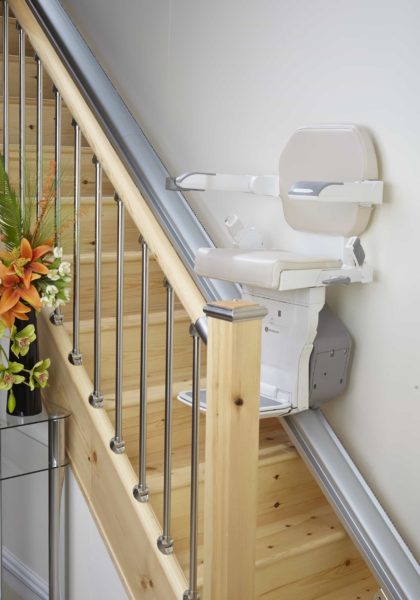
There are certainly benefits to both. A stairlift is a major purchase, but that doesn’t mean people don’t change their minds — or situations change, eliminating the need for a lift.
Consider this scenario:
A son purchases a stairlift for his father. Before the lift is even installed, his father has a stroke and must move to a nursing home for an indefinite period of rehabilitation/recovery. The family may decide to keep the lift for a while, but if it seems that Dad will not be able to come home again (and since the median cost of nursing home care is in the $90,000 per year range), they may decide it’s best to sell the never-been-used lift as soon as possible. Pre-owned doesn’t always mean “used.” However, a manufacturer’s warranty may not carry over to you, the new owner.
Unless you are prepared to repair or resolve any lift glitches on your own time and dime, having that warranty coverage may be enough motivation for you to buy new. If you decide to go pre-owned, don’t just take the seller’s word on the quality of the lift. Have a trained professional inspect it thoroughly to ensure that it was well maintained and is in good shape. Also, hire a professional to measure and install the lift so that you know it will fit into your home precisely (do you have a straight stair rail or a curved one? these features vary, as do installation requirements) and that it is working properly.
Follow these guidelines for making the purchase that is right for your family’s needs and budget:
Research the company (or seller) you are buying from.
Make sure the company or individual will stand behind the product. We at 101 Mobility offer only stairlifts from the most trusted, reliable, and safe brands in the industry. We are so confident in our products that we include a complimentary one-year service warranty on all new stairlifts we sell and install.
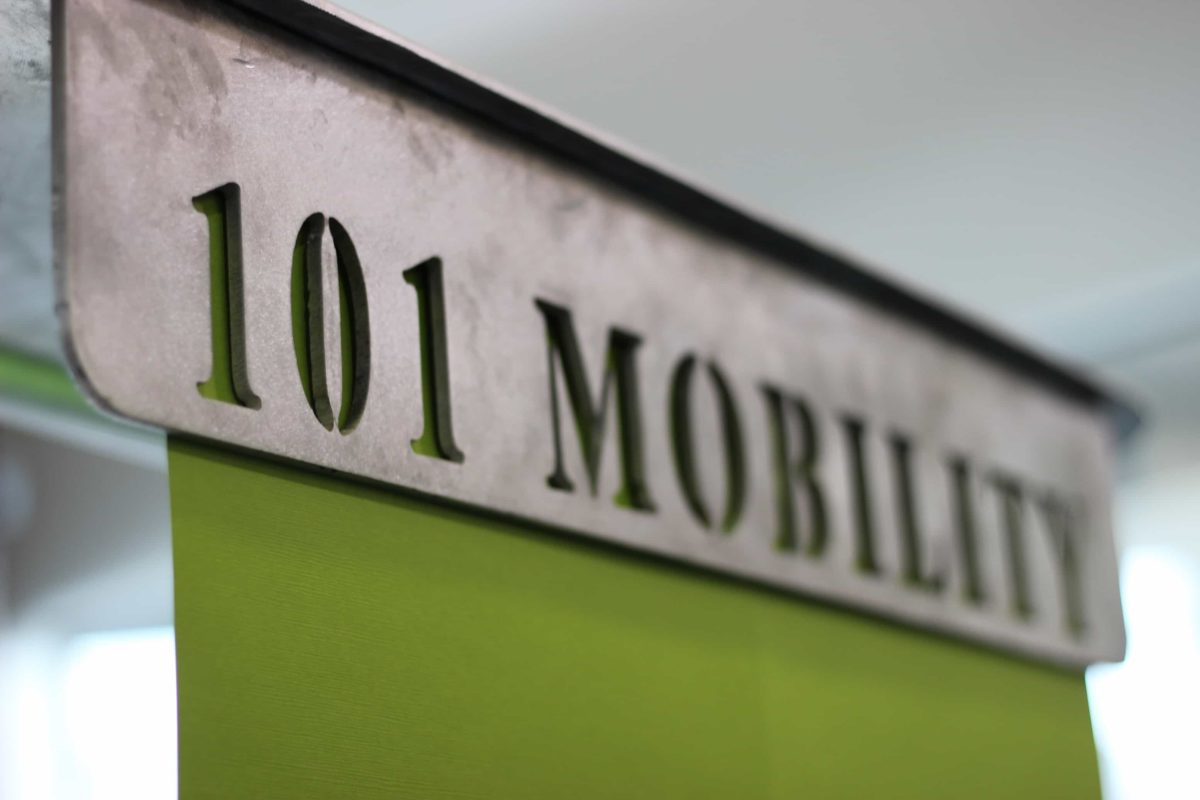
Consider additional warranty options or extended coverage.
Some companies offer extended coverage plans for your stairlift, so you don’t have to worry about unexpected issues down the road once your original warranty expires.
Buying online?
Buyer beware: Many online companies prey on consumers by anonymously selling stairlifts over the internet at steep attractive discounts. However, the costs incurred by making this mistake are usually far greater than buying from a company that is local, well- trusted, and has a history of completing jobs professionally from start to finish. Another downside of purchasing online? The companies generally send the product in several boxes, without direction or support included. Even if you hire a professional to help you install the lift, chances are, he has never worked with the equipment before.
Can I Install the Stair Lift Myself?

There are many factors that must be considered when installing a stair lift. No matter how handy you may be, you are likely to commit critical mistakes during installation. Since a stair lift is by no means a small or straightforward piece of equipment, self-installation without proper training or experience inevitably increases your cost and poses severe safety risks. Instead, seek out a local company that guarantees the precise and safe installation of all their equipment.
Check their records too: ask if service technicians are factory-trained and certified, and find out their level of experience and expertise (i.e. How many hours of training have they completed? How long have they been with the company? How long have they performed stair lift installations?).
CAN I RENT OR LEASE A STAIR LIFT?
Renting a stair lift may be a good option. As with any major purchase decision, choosing to rent or buy depends on your personal situation — for instance, your budget — and your need for the lift. If the need is long-term, it may make sense to purchase one. However, if you are looking for a temporary solution, renting is a viable solution.
If you choose to rent a stairlift, know that certain models or variations of lifts may not be available. For example, a lift that fits a curved stair rail is a customized piece of equipment, so you will not be able to rent one. Before moving forward with a rental, consider how long you will need the lift. Estimate your costs in terms of “rent versus buy” based on the period of time the lift will be in use. Be sure to ask the company if there are additional charges for damage (accidental or otherwise) and general wear and tear assessed upon return of the lift.
As always, it is best to choose a reputable local company that employs trained service technicians — saving time, money, and sanity (things you can’t afford to waste if you are caring for someone who requires a stairlift).
CAN MY HOUSE SUPPORT A STAIR LIFT?
Some approach a stairlift installation with apprehension and anxiety. You may wonder if the stairlift itself, or the installation process, will damage your stairway. You may be concerned about resale value, especially if you need to remove the lift before selling the home, or if the primary user transitions to a caring community. Perhaps you have an older home and are worried about the structural impact of a stairlift installation.
These concerns are certainly valid, but the reality is that the units mount into the steps themselves, not the wall. Steps are built to handle a great deal of pressure, and nearly all homes that exist today are capable of supporting stairlifts Again, it comes back to the importance of hiring trained professionals to complete the installation. A qualified and experienced technician knows the specifications and requirements of your lift; they can ensure that your steps can support the lift, and easily make it look and feel like a natural part of your home. If you are concerned about damage to your home upon removal of the lift, proper installation and maintenance are key.
Competent, professional installers are capable of removing the lift without leaving behind more than a few small holes, which can be easily filled or covered. An installer will also take into account the landing areas, the proximity of doorways, location of usable outlets, and other factors when putting your lift in place. Stairlift options on today’s market run the gamut: colorful, comfortable, and quiet designs are available to make the lift integrate seamlessly with your home’s personal style (and the user’s preferences too).
WHICH STAIRLIFT IS BEST?
Once you’ve considered the costs, explored funding options, determined that your home can support this modification, and decided between renting and buying, the next big decision is choosing which stairlift is the best for your needs.
WHAT TYPES OF STAIRLIFTS ARE AVAILABLE?
Popular Highly Rated Straight Rail Stair Lifts
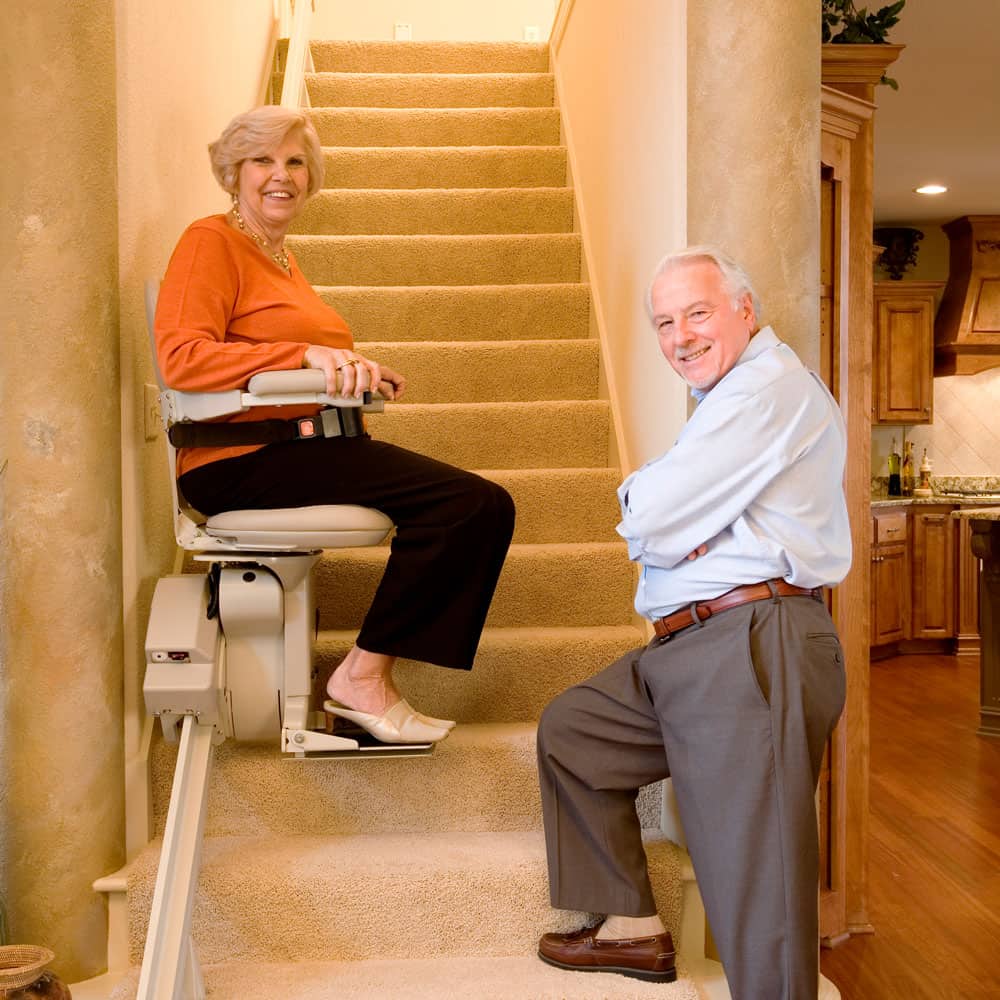
-
Bruno Elan Straight Rail Stairlift: 300 lbs. capacity; rail installs as close as 3” from the wall; the dual-braking system makes it one of the safest stairlifts in the world; optional folding rail available to remove rail obstruction at bottom of stairs.
-
Bruno Elite Straight Rail Stairlift: 400 lbs. capacity; rail installed as close as 5.25” from the wall; seat, footrest, and armrest fold up to reduce stairway obstruction
-
Harmar Pinnacle: 350 lbs. capacity; when folded, the unit takes up only 11” of space; 10-year warranty on gear rack; mounts to either left or right side of the stairway.
-
Harmar Pinnacle Heavy Duty: 600 lbs. capacity; boasts a heavy-duty frame and a wide, contoured seat with extra-high molded seat back for maximum comfort.
-
Harmar SL350AC: 250-350 lbs. capacity depending on track length; boasts a pre-installed carriage on a short section of the track; only AC powered stairlift.
-
Harmar Vantage: 300 lbs. capacity; the Vantage’s internal speed regulator guarantees a smooth ride up and down the stairs while its covered gear rack makes the unit virtually maintenance-free.
-
Handicare Xclusive: 286 lbs. capacity; the Xclusive’s ergonomic toggle control allows the user easy and painless chair operation; boasts soft, high-wear armrests shaped to suit the curvature of your hands.
More Information on Straight Stair Lifts
Highly Rated & Popular Custom Curved Rail Stair Lifts
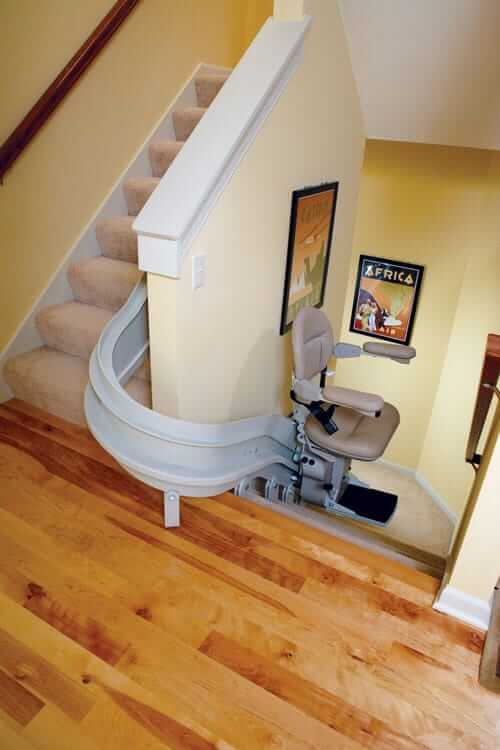
-
Bruno Curve Elite (Indoor): 400 lbs. capacity; offset swivel seat for easy boarding and exiting on top landing; flip-up arms, seat, and footrest for extra space; charges at top and bottom of rail; power options available; gold warranty standard.
-
Harmar Helix Curved Stairlift: 350 lbs. capacity; offset swivel seat for easy boarding and exiting on top landing; charge strips at the top and bottom landing for the charge; flip-up arms, seat, and footrest for extra space; dual rail system; free limited warranty.
-
Handicare 2000 Curved Stairlifts: 250 lbs. capacity; manual flip-arms, seat, and footrest for extra space; safety sensors for obstruction detection; two wireless remotes; top and bottom rail charging; warranty available.
More Information on Custom Curved Rail Stair Lifts
Recommended Outdoor / Outside Stair Lifts
-
Bruno Curve Elite: 400 lbs. capacity; a high-quality, curved rail stairlift that performs in nearly any weather condition – hot or cold, rain or snow; comes with adjustable-width armrests and multiple seat heights and a weather-resistant cover that travels with the chair; upholstered with marine-grade vinyl; painted with strong outdoor paint for maximum durability against the elements.
-
Harmar Helix Curved Stairlift: 350 lbs. capacity; advanced custom contoured rails make for a smooth and quiet ride up and down any staircase; emergency stop feature; a narrow profile and customizable upholstery option; includes adjustable arm width for maximum comfort.
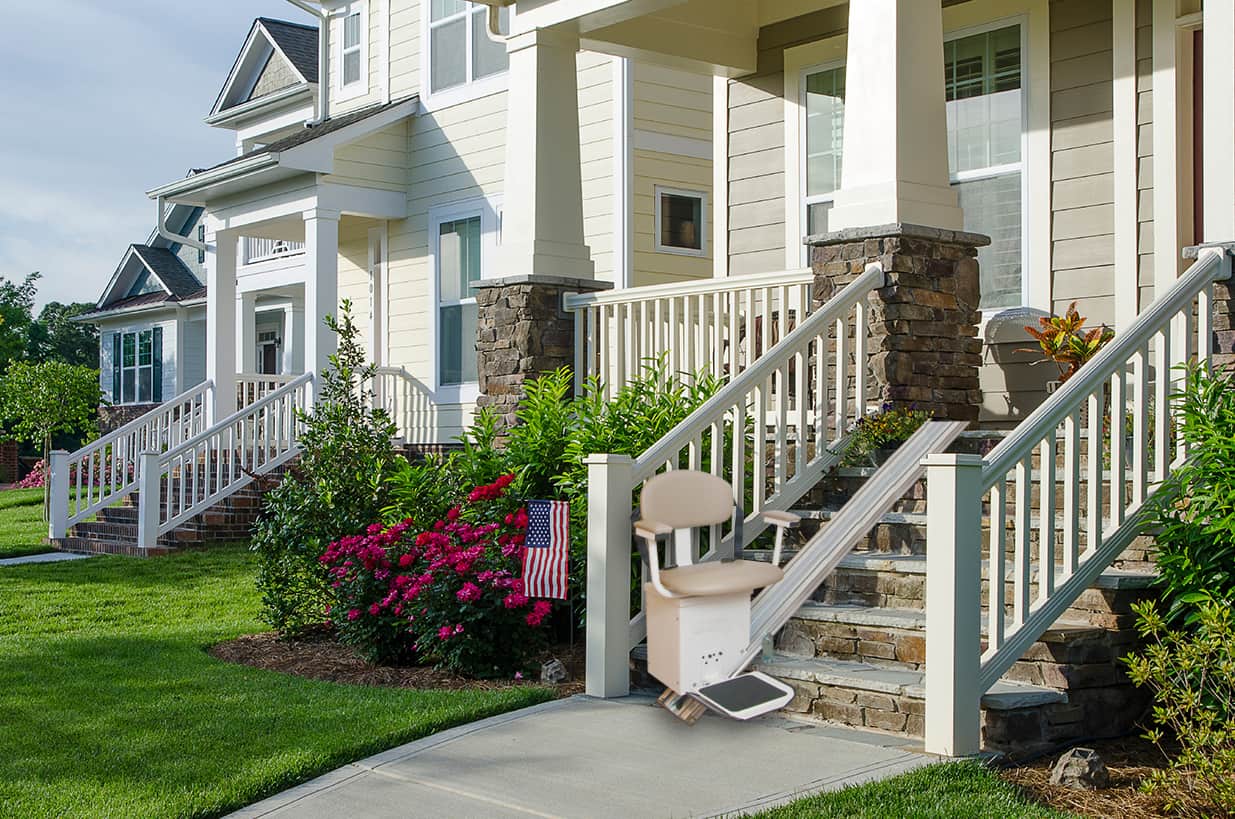
-
Handicare 1000 Outdoor Stairlift: 350 lbs. capacity; slimmest rails on the market; ergonomic toggle control allows any user easy and painless chair operation; includes a keyed lock-out feature and a waterproof cover; upholstered with UV-protected, Slate Grey upholstery.
-
Bruno Elite Straight: 400 lbs. capacity; a high-quality, straight rail stairlift that is designed to withstand harsh environments; gives you the ability to enjoy the outside of your home safely; includes same features as Bruno Curve Elite such as armrests, weather-resistant cover, etc.
-
Harmar SL350OD: 350 lbs. capacity; weather-proofed to withstand the elements; includes a header, internal chassis, and large weatherproof cover for additional protection; upholstered with exterior marine-grade vinyl for extra durability; only commercial rated outdoor stairlift.
More Information on Outside Stair Lifts
YOUR NEXT STEPS
So what happens next?
Step 1: Consultation with an installation or sales professional.
Step 2: Assessment of stairway.
Step 3: Product selection and proposal.
Step 4: Equipment is ordered.
Step 5: Installation begins.
Step 6: Training on how to safely operate the stair-lift (all household residents and caregivers should be trained).
Step 7: Warranty is explained thoroughly by your mobility specialist.
STAIRLIFT SAFETY TIPS
-
Buckle up! Stairlifts come with seat belts that are helpful to ensure that the user does not lose balance or become unsecured while the unit is operating.
-
Lock it up! Children often want to play on stairlifts, but this can be dangerous. If you will have children at the home with the stairlift, ask about a unit with a key that can be used to disable operation for all individuals other than the primary user.
-
Watch your step! Stairlift railings must extend beyond the last step of your staircase to enable proper navigation. If this will be in a foyer, hallway, or other heavily-traveled areas, consider a flip-up rail that can remove the potential for a tripping-hazard.
-
Dismount carefully! Stairlifts generally require the user to get on and off very close to the top of the staircase. Individuals who are unsteady or have compromised balance should consider an extended railing which would move the seat away from the top of the steps to a safer location nearby.
-
Know your limits! Like a roller-coaster, all units have weight limits. Never overload the unit – this could result in a dangerous situation.
-
Fold it up! The seat bottoms, armrests, and footrests on all stairlifts can be folded up when not in use to increase the walkable space on the staircase, increasing safety for any individuals who will not be using the stairlift.
According to this article on stairlift safety from eHow.com, approval from the American Society of Mechanical Engineers (ASME) “indicates that the manufacturer has followed specific safety standards and guidelines when building the stairlift.” For added peace of mind, check with your lift provider to determine if their products are ASME-approved.
ABOUT US
Headquartered in Wilmington, North Carolina, 101 Mobility is pleased to provide and install a broad range of high-quality mobility equipment from manufacturers such as Bruno, Harmar, Savaria Concord, EZ Access, Pride, Invacare, Medline, Golden Technologies, Liko, ActiveCare, Sterling, Drive, Aqua Creek, and SAPA-Redd. Thousands of physically-challenged customers count on us for our exceptional products such as stairlifts, auto lifts, ramps, porch lifts, power wheelchairs, patient lifts, specialty lifts, home safety and access equipment, and more. We’re proud to tell you that we’re one of the largest dealers of our products, and we have a considerable presence in multiple states across the country. We meet every customer face-to-face and continue offering excellent service long after the sale.
